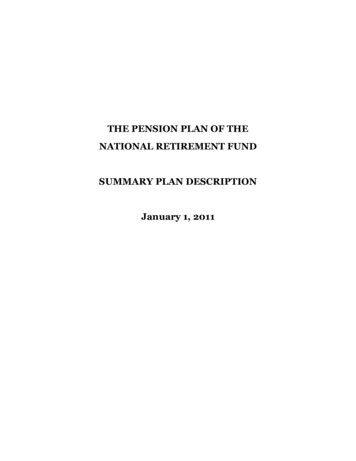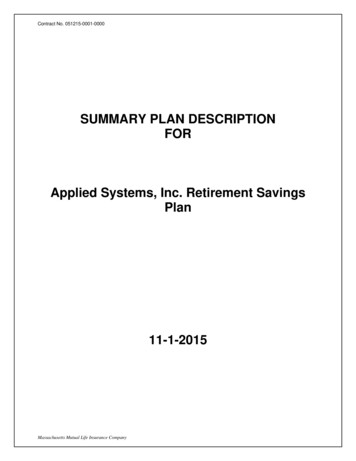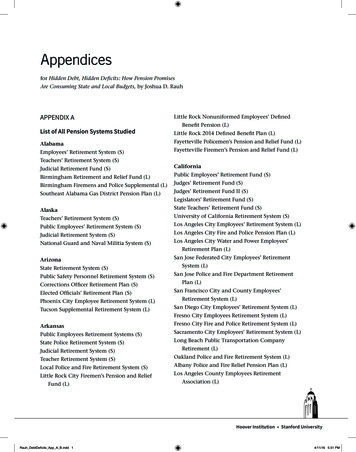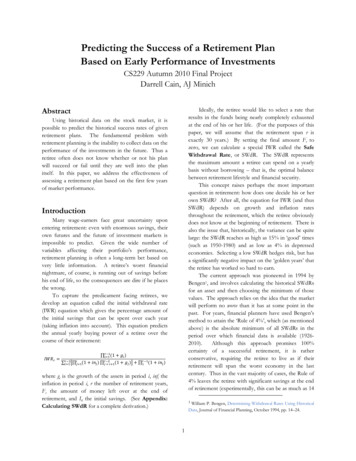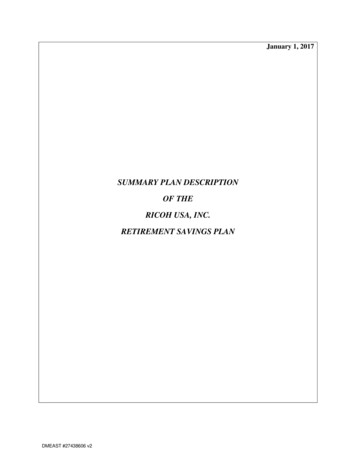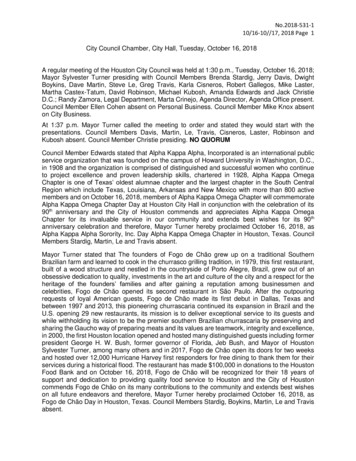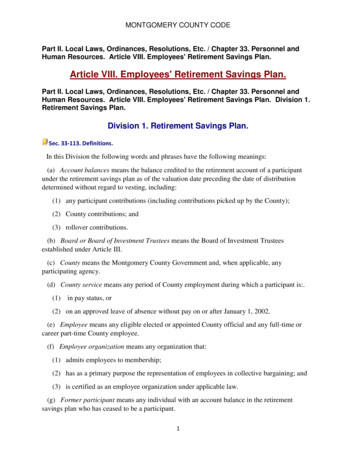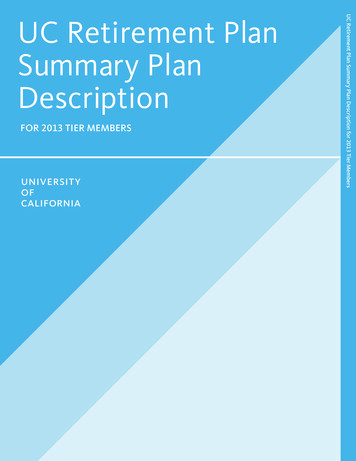
Transcription
FOR 2013 TIER MEMBERSUC Retirement Plan Summary Plan Description for 2013 Tier MembersUC Retirement PlanSummary PlanDescription
Listed below are telephone numbers and website andcorrespondence addresses for some of the resources UCemployees routinely use.UC EMPLOYEE WEBSITEucnet.universityofcalifornia.eduUC RETIREMENT ADMINISTRATION SERVICE CENTER800-888-8267Hours: 8:30 a.m.–4:30 p.m., Monday–FridayWritten correspondence should be sent to:UC Human ResourcesP.O. Box 24570Oakland, CA 94623-1570LOCAL BENEFITS OFFICESYour local Benefits Office is a resource for answers to questionsabout your benefits and for benefits publications and forms.The following is a contact list for local campus and lab BenefitsOffices.UC Berkeley: 510-664-9000, option 3UC Davis: 530-752-1774UC Davis Health: 916-734-8099UC Irvine: 949-824-0500UC Irvine Health: 949-824-0500UCLA: 310-794-0830UCLA Health: 310-794-0500UC Merced: 209-355-7178UC Riverside: 951-827-4766UC RETIREMENT AT YOUR SERVICE (UCRAYS)retirementatyourservice.ucop.eduSign in to your account to send a secure messageUC RETIREMENT CHOICE ANDRETIREMENT SAVINGS PROGRAMmyUCretirement.com866-682-7787 (Fidelity Retirement Services)INVESTMENT OVERSIGHTUC Office of the Chief Investment OfficerChief Investment Officer’s website: ucop.edu/investment-officeWritten correspondence should be sent to:Office of the Chief Investment Officer of the RegentsUniversity of CaliforniaOffice of the President1111 Franklin StOakland, CA 94607-9828BENEFITS FROM OTHER SOURCESFor information on plans and services that may affect yourretirement benefits, such as Social Security, CalPERS or otherretirement plans and agencies, contact the appropriate agency.Social Security Administration: 800-772-1213Social Security website: socialsecurity.govCalPERS: 888-225-7377CalPERS website: calpers.ca.govCalSTRS: 800-228-5453CalSTRS website: calstrs.comUC San Diego: 858-534-2816UC San Diego Health: 619-543-3200UCSF: 415-476-1400UCSF Health: 415-353-4545UC Santa Barbara: 805-893-2489UC Santa Cruz: 831-459-2013Agriculture & Natural Resources: 530-752-1774ASUCLA: 310-825-7055Hastings College of the Law: 415-565-4703UC Office of the President: 855-982-7284Lawrence Berkeley National Lab: 510-486-6403IF YOU MOVEIt is your responsibility to notify the Plan Administrator of yournew mailing address. UC uses the address on file as the addressof record for you and your beneficiaries.If you are an active UC employee or retiree, you can changeyour address by signing in to your UCRAYS account atretirementatyourservice.ucop.eduIf you’re no longer working for UC or do not have internetaccess, you can also notify UC Human Resources by calling theUC Retirement Administration Service Center at 800-888-8267.Or, if you have internet access, select “HR Forms & Publications”on UCnet and print and complete form UBEN 131 (UC HumanResources Address Change Notice) and mail it to UC HumanResources.
Chapter TitleRetirement Plan: Summary Plan DescriptionFor 2013 Tier MembersIntroduction.5Membership.6Social Security.6Eligibility and Membership.6Vesting.6Inactive Membership.7Reciprocity.7Contributions.8Funding the Plan.8University Contributions.8Member Contributions.8Service Credit.8Service Credit Purchase.10Refund of Accumulations.10Retirement Benefits.11If You Leave UC and Don’t Retire.11Basic Retirement Income.11Alternate Monthly Payment Options.12Retirement Age Factors.12Plan Maximum Benefit.13Death Benefits.14Payments to Beneficiaries.14Preretirement Survivor Income.14Death While Eligible to Retire.14Cost-of-Living Adjustments.15Disability Benefits.15General Requirements.15Disability Definitions.15Disability Date.16Disability Income.16Benefit Election.16Maximum Disability Income.16Applying for Disability Benefits.16Length of the Disability Income Period.16When Disability Income Stops.16Reappointment After Retirement.17Internal Revenue Code Provisions.17Maximum Benefit Limitations.17Minimum Distribution Incidental Benefit.17Minimum Required Distributions.18Rollovers.18Taxes on Distributions.18Additional Information.19Claims Procedures.19Plan Administration.19Plan Changes.20Designation of Beneficiary or Contingent Annuitant.20Assignment of Benefits.20Special Provisions for AFSCME, CNA and UPTE.21Qualified Domestic Relations Orders (QDRO).21Further Information.21Plan Definitions.22Information for Members with Service Creditfrom a Previous Period of Employment.253
4
IntroductionThe University of California Retirement Plan (UCRP or the Plan)provides retirement benefits for eligible employees (and theireligible survivors and beneficiaries) of the University of Californiaand its affiliate, Hastings College of the Law. UCRP also providesdisability income and death benefits.UCRP is a tax-qualified governmental defined benefit plan.Eligible employees automatically become members of UCRP as acondition of employment. Benefits are determined by formulasthat vary according to the type of benefits payable (for example,retirement, disability or survivor benefits). The formulas arebased on such factors as a member’s salary, age, years of servicecredit and member class. The Plan is funded by employer andemployee contributions.The provisions of the 2013 Tier described here are subject tocollective bargaining for represented employees.Are you in a domestic partnership?Eligibility rules for domestic partners are different for healthand welfare benefits and for UCRP benefits. See page 22, orcheck out “Establishing a domestic partnership” on UCnet(ucal.us/domesticpartnership), to make sure you’veestablished your partner’s eligibility for UCRP survivor anddeath benefits.5
MembershipMembershipThe Plan includes four member classes:ELIGIBILITY AND MEMBERSHIP Members who pay into Social SecurityUCRP membership is automatic and mandatory for eligibleemployees and begins the first day of an eligible appointment.An eligible appointment is at least 50 percent time on a fixed orvariable basis for one year or longer. Members who opted out of Social Security coverage, otherthan Safety members Members with Tier Two benefits and Safety membersActive members in each of the first two member classes accruebenefits in one of four tiers—the 1976 Tier, the 2013 Tier, theModified 2013 Tier and/or the 2016 Tier. A member who firstbecomes eligible to participate in UCRP on or after July 1, 2016,will accrue benefits in the 2016 Tier. A member who beganaccruing UCRP benefits before July 1, 2016, will continueaccruing UCRP benefits under his/her current tier until he or shehas a tier break in service (see definition on page 22). If themember returns to eligible UC employment on or afterJuly 1, 2016, following a tier break in service and again becomesa UCRP member, the member will accrue additional serviceunder the 2016 Tier.Employees with limited appointments, in contract positions, in“noncareer” positions at the Lawrence Berkeley NationalLaboratory and certain academic employees may becomeeligible for membership after working 1,000 hours in a rolling,continuous 12-month period. (Employees in a Non-SenateInstructional Unit qualify for UCRP membership after working750 hours in an eligible position.) Membership is effective nolater than the first of the month following the month in which1,000 hours (or 750 hours) is reached.EXCEPTIONS:A University employee is not eligible for Plan membership if heor she: Is at the University primarily to obtain education or trainingThis summary plan description is directed to members currentlyaccruing benefits under the 2013 Tier. The provisions startingon page 25 provide additional information for members whoalso accrued benefits under the 1976 Tier. The provisions of the2013 Tier described here are subject to collective bargaining forrepresented employees. Receives pay under a special compensation plan but receivesno covered compensation (see “Plan Definitions” on page 22)All other members and those who have University service inmore than one member class should refer to the appropriatesummary plan description(s) because benefits and otherprovisions vary.Once you become a UCRP member, active membership continuesuntil you have a break in service (see “Plan Definitions” on page22). Membership is not affected by a reduction in appointmentwithout a break in service. Benefits based on future service maychange if you transfer to a position eligible for Safety benefits. Is in a per diem, floater or casual restricted appointment Is appointed as a Regents’ Professor or Regents’ Lecturer Is an employee hired as a visiting appointeeSOCIAL SECURITYMost UCRP members in the 2013 Tier pay Social Security taxes.1The Social Security tax rate is currently 7.65 percent. Of this, themember pays 6.2 percent on earnings up to the Social Securitywage base ( 147,000 in 2022) for Old Age, Survivors andDisability Insurance (OASDI) and 1.45 percent on all earnings forMedicare hospital insurance (Part A). These taxes are calculatedbased on the member’s wages each pay period, after any pretaxdeductions for medical plan premiums, flexible spendingaccounts and the Pretax Transportation Program.Contact the Social Security Administration for moreinformation about Social Security eligibility and benefits,including an estimate of future retirement benefits (seeinside front cover).16Members who opted out of Social Security in 1976 and return to UCemployment on or after July 1, 2013 will not pay Social Security taxes.VESTINGTo vest means to acquire certain rights. Once vested, yougenerally have a non-forfeitable right to receive UCRPretirement benefits upon leaving the University and reachingretirement age. You must earn five or more years of servicecredit to be vested.You become vested in your Plan benefits whether you earn allservice credit as a member in one UCRP member class or tier orin multiple UCRP member classes and tiers.
MembershipINACTIVE MEMBERSHIPTo establish reciprocity, you must:You become an inactive member upon leaving Universityemployment and retain the right to future retirement benefitsby leaving your accumulations (employee contributions plusinterest) in the Plan, provided you satisfy one of the followingcriteria: Be employed under the other retirement system within 180days of leaving employment under the former system Have at least five years of service creditWhen you elect UCRP/CalPERS reciprocity, funds are nottransferred from one retirement system to the other. Youbecome a member of both systems. You are subject tomembership and benefit obligations and rights of each system.You must retire under both systems on the same date for thebenefits of reciprocity to apply. Are eligible for reciprocity (see “Reciprocity” below) Were medically separated from University employmentand are eligible to apply for UCRP disability income (see“Disability Income” on page 16) Are a faculty member of a University medical school whohas been appointed by the Veterans Administration to aUniversity-affiliated hospital, and, as a result, receive nofurther covered compensation or Became a Plan member July 1, 1989, or earlier, and reachedage 62 while still an eligible employeeAfter leaving the University, an inactive member may, at anytime before (and in lieu of) retiring, request a refund of accumulations. If you elect a refund of accumulations, you waive theright to any future Plan benefits (see “Refund of Accumulations”on page 10).If you leave before becoming an inactive member (that is, amember with five years of service credit), you may also requesta distribution of your accumulations at any time. You will loseany service credit you have accrued unless you later return to UCemployment and reestablish it. Leave your accumulations (if any) in the former system and Elect reciprocity by completing the proper forms (see below)To establish reciprocity at UC, you must complete form UBEN157 (Election of Reciprocity) and send it to UC Human Resources.The form is part of the UCRP/CalPERS Reciprocity Fact Sheet,available at ucal.us/reciprocity. To find out how to establishreciprocity at CalPERS, call CalPERS directly (see inside frontcover). As long as you remain eligible under the guidelines listedabove, you may establish UCRP/CalPERS reciprocity at any timeprior to retiring.A provision for concurrent retirement is also available for UCRPmembers who are also members of the California State Teachers’Retirement Defined Benefit Program (CalSTRS). You are eligiblefor concurrent retirement if you: Become an active UCRP member on or after July 1, 2002 Are a member of CalSTRS and Elect UCRP retirement income after July 1, 2002 Have satisfied the applicable age and service requirements forearly retirementRECIPROCITYUCRP and the California Public Employees Retirement System(CalPERS) have a reciprocal agreement to ensure continuity ofbenefits for members who change employers and transferbetween the two retirement systems under certain circumstances.If you qualify for reciprocity with CalPERS, service credit accruedunder both systems can be used to determine whether you arevested in benefits under both retirement systems. Also, coveredcompensation earned under both systems can be used todetermine your highest average plan compensation under bothsystems. If you retire for disability under CalPERS, you will besubject to the limitation on the maximum total benefits that canbe provided under both systems. The reciprocal agreement doesnot apply to eligibility for retiree health benefits.Members eligible for concurrent retirement receive benefitssimilar to those for reciprocity. CalSTRS has similar concurrentretirement provisions that apply to UCRP members; for moreinformation about CalSTRS concurrent retirement, contactCalSTRS directly.7
Contributions, Service CreditContributionsService CreditFUNDING THE PLANService credit is the measure of time you have participated inthe Plan in one or more member classes. Service credit is used todetermine eligibility for most benefits and to calculate benefitssuch as monthly retirement.Plan benefits are funded by contributions from both the University and active members and by the investment earnings on Planassets. These contributions and earnings are placed in a trustfund and constitute a single pool of assets. Annual actuarialvaluations determine the Plan’s liabilities (that is, projectedbenefits to be paid) and the funding status.The UC Board of Regents periodically adjusts University andmember contribution rates to maintain adequate funding levels.Service credit is earned whenever you receive covered compensation for an eligible appointment. The maximum that you canearn for a year of full-time work is one year of service credit.Part-time or variable-time work results in a proportionateamount of service credit. For example, if you work 50 percenttime for one year, you receive one-half year of service credit.UNIVERSITY CONTRIBUTIONSSICK LEAVEUniversity contributions are used to pay Plan benefits for allmembers, and are not allocated to individual member accounts.If you retire within four months after leaving the University, anyunused sick leave is converted to service credit. Eight hours ofunused sick leave converts to approximately one day of servicecredit. Sick leave converted to service credit cannot be used toreach the five years of service credit needed to be eligible forretirement benefits. But, because service credit is part of thebenefit formula, this additional service credit may increase yourmonthly retirement income.MEMBER CONTRIBUTIONSMost active 2013 Tier members make contributions to UCRPequal to 7 percent of covered compensation. Adjustments tomember contributions are subject to collective bargaining.Members of CNA, UPTE and AFSCME: see “Special Provisions”on page 21 for information about member contributions.UCRP contributions are deducted automatically from your grosswages each pay period and credited to your individual memberaccount. Wages on which contributions are assessed are calledcovered compensation. Your contributions to the Plan arededucted on a pretax basis and, therefore, reduce your taxableincome.The Plan Administrator maintains a record of each member’sUCRP contributions and credits the amount with interest at astated rate (currently 6 percent per year).8DISABILITY STATUSIf you become disabled and receive UCRP disability income,you may continue to earn service credit at the same rate earnedduring the 12 months of continuous service just before yourdisability date.You continue to earn service credit until or unless increasedservice credit would cause your retirement benefit, if you wereto retire, to exceed your disability benefit.
Service CreditPARTIAL-YEAR CAREER APPOINTMENTSSABBATICAL OR PAID LEAVEIf you work full time during a 9-, 10-, or 11-month partial-yearappointment, you earn one year of service credit for each Planyear. If you work part time during a partial-year appointment,you earn proportionate service credit. For example, if you work50 percent time during a partial-year appointment, you earnone-half year of service credit. See page 24 for an explanation ofthe potential effect of a partial-year career appointment on yourhighest average plan compensation (HAPC).During a sabbatical or paid leave, you earn service credit inproportion to the percentage of full-time pay you receive. Forexample, if you are on sabbatical leave at two-thirds pay for oneyear, you receive two-thirds of a year of service credit, but youmay be able to purchase service credit for the unpaid portion ofyour leave (see the UCRP Service Credit Purchase Guide, availableonline at ucal.us/purchase).EXTENDED SICK LEAVEMILITARY LEAVEIf you return to University service in accordance with yourreemployment rights following a military leave, you receiveservice credit for the time spent in uniformed service and for aperiod following uniformed service, provided you return to workwhen the leave ends and satisfy other applicable requirements.You earn service credit for military leave at the same rateearned during the 12 months of continuous service just beforethe leave. For example, if you earned three-fourths of a year ofservice credit in the 12 months just before military leave, youwill earn three-fourths of a year of service credit for a year ofmilitary leave.The Retirement Administration Service Center or your localBenefits Offices can provide more information aboutestablishing service credit for military leaves.You earn up to 80 percent of service credit for periods ofextended sick leave during which you receive Workers’Compensation, but you may be able to purchase service creditfor any remaining percentage (see the UCRP Service CreditPurchase Guide, available online at ucal.us/purchase).PAST SERVICEIf you have previous Plan membership, you retain service creditfor the earlier period if you leave your accumulations in the Planupon leaving the University. If you previously received a refundof accumulations for the earlier period, you may purchaseservice credit for the earlier period, subject to the rulesdescribed in the UCRP Service Credit Purchase Guide, availableonline at ucal.us/purchase. If you previously retired and receiveda lump sum cashout, you may not purchase service credit for anyperiod before the cashout date.LEAVE WITHOUT PAYYou do not earn service credit during a leave without pay, butyou may be able to purchase service credit (see the UCRP ServiceCredit Purchase Guide, available online at ucal.us/purchase).9
Service Credit Purchase, Refund of AccumulationsService Credit PurchaseRefund of Accumulations“Service Credit Purchase” (formerly known as “buyback”) ispayment to establish service credit for eligible leaves or toreestablish service credit purchase for previous UCRPmembership. The service credit purchase option is available onlyto active UCRP members.Upon leaving University employment, you may receive adistribution of your Plan accumulations or leave them in the Plan(University contributions must remain in the Plan).THE SERVICE CREDIT PURCHASE OPTIONIS AVAILABLE FOR:APPROVED LEAVESApproved leave without pay; partially paid sabbatical leave;extended sick leave; temporary layoff or furlough (except duringa partial-year career appointment); orPREVIOUS UCRP MEMBERSHIPUCRP service for which a refund of accumulations was received.THE SERVICE CREDIT PURCHASE OPTIONIS NOT AVAILABLE FOR: Any break-in-service period Any period of ineligible service, such as temporaryemployment or indefinite layoff Any furlough during a partial-year career appointment A reduction in appointment Any period of CalPERS membership Any period of service that preceded a lump sum cashout Any period of less than four weeks, unless necessary forvesting purposes Any period of military leave July 1, 1966, or later (The memberreceives full service credit without making contributions.) Time worked as a participant in Savings ChoiceYou can find complete information as well as instructions inthe UCRP Service Credit Purchase Guide, available on UCnetat ucal.us/purchase.10If you are eligible for inactive membership, however, a refundof accumulations cancels your right to any future Plan benefitsbased on that period of service unless you return to Universityemployment and reestablish the service credit (see theUCRP Service Credit Purchase Guide, available online atucal.us/purchase).A refund of any remaining accumulations after your death isconsidered a death benefit (see “Death Benefits” on page 14).
Retirement BenefitsRetirement BenefitsYou can elect to retire and receive benefits at any time after youbecome eligible—that is, when you reach age 55 and leaveUniversity employment with at least five years of servicecredit. 2, 3If You Leave UC and Don’t RetireIn most cases, vested members who leave Universityemployment and do not, or are not eligible to, retire at thetime they separate should not delay electing retirementbenefits past age 65. Generally, at age 65, an inactivemember will have attained the maximum UCRP benefitpayable under the Plan.HOW RETIREMENT INCOME IS CALCULATEDThe calculation of basic retirement income is a two-step process:1. Calculate the benefit percentage (not to exceed 100%):Service credit x age factorThe age factor is based on your age in complete years andmonths on the date of your retirement as shown in the charton page 12.Example:A member retires at age 65 (age factor .0250), with 20 yearsof service credit.20 years x .0250 50.0% (benefit percentage)BASIC RETIREMENT INCOMEBasic retirement income is your normal monthly lifetime benefit.This basic amount is adjusted if you want to provide monthlysurvivor income for a spouse, domestic partner or anotherperson (see “Alternate Monthly Payment Options” on page12). Also, your benefit must be adjusted if the monthly benefitexceeds maximum benefit levels. See “Plan Maximum Benefit”on page 13 and “Internal Revenue Code Provisions” on page 17for more information.Basic retirement income is a percentage of your average salary,or HAPC (highest average plan compensation; see definition onpage 24). The percentage is based on your service credit and ageat retirement.2. Multiply the benefit percentage by your highest averageplan compensation or HAPCHAPC is the member’s average monthly salary (full-timeequivalent com
Hastings College of the Law: 415-565-4703 UC Office of the President: 855-982-7284 Lawrence Berkeley National Lab: 510-486-6403 UC RETIREMENT AT YOUR SERVICE (UCRAYS) retirementatyourservice.ucop.edu Sign in to your account to send a secure message UC RETIREMENT CHOICE AND RETIREMENT SAVINGS PROGRAM myUCretirement.com
